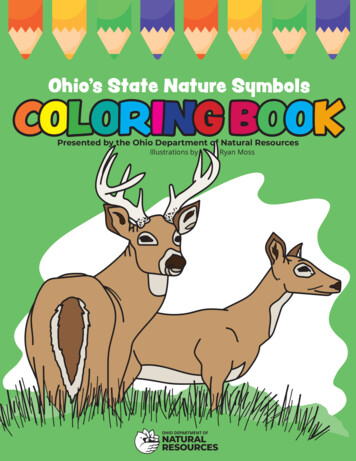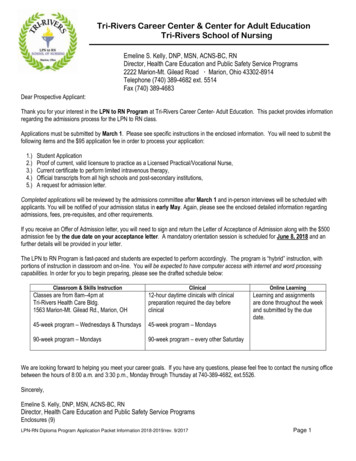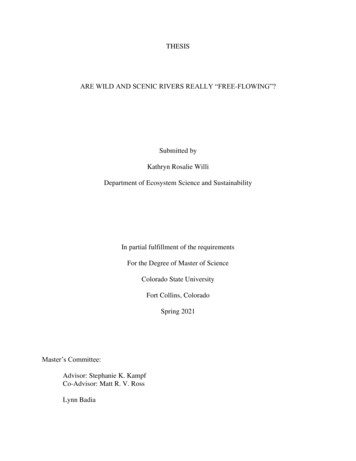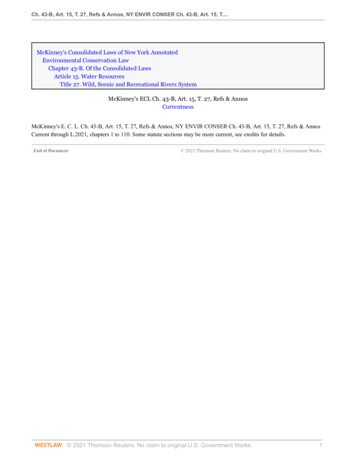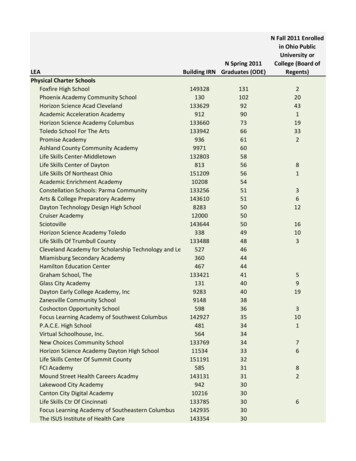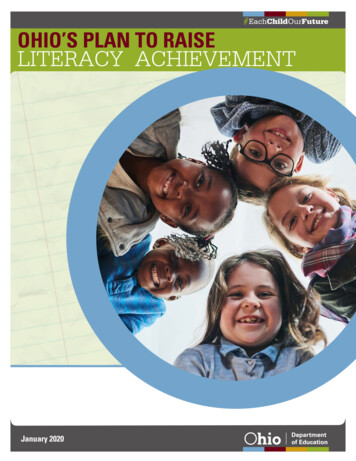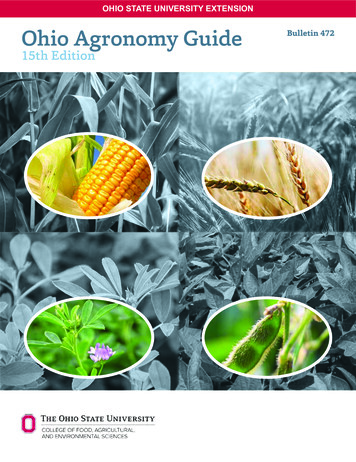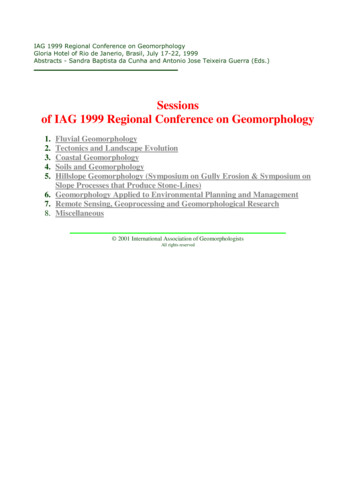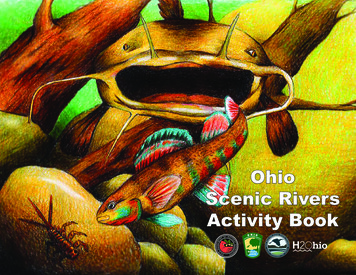
Transcription
OhioScenic RiversActivity BookH2 hio
Welcome to the world of aquatics bugs!This activity book features some of the macroinvertebrates that are found in Ohio’s streams. Macroinvertebrates.That’s a big word. Let’s break it down: “Macro” refers to objects that are large enough to see without a microscope, and“invertebrate” is an organism without a backbone.Macroinvertebrates, sometimes called “bugs,” include insects, crustaceans, worms, and snails to name a few.Some of these tiny bugs need very clean water to survive, while others can live just about everywhere, even inpolluted water. Finding macroinvertebrates that need clean water is a sign that a river is healthy. Volunteers helpthe Ohio Scenic Rivers Program look for macroinvertebrates to make sure our state scenic rivers are healthy.Keep reading to learn more about what different bugs need, what they eat, and what eats them! Look for thesevocabulary words in bold used throughout this activity book.Aquatic - growing or living in the waterCarnivore - an animal that eats only meatFood web - a series of living things that shows how each organism is connected to the next organism.Also known as a food cycleLifecycle - the series of changes a living thing goes through during its lifeHerbivore - an animal that eats only living plantsLarva - the young stage of a bug that will undergo a complete metamorphosisMetamorphosis - the change from one form to another Incomplete Metamorphosis - the change from egg to nymph, then nymph to adult Complete Metamorphosis - the change from egg to larva, larva to pupa, and from pupa to adultNymph - the young stage of a bug that will go through an incomplete metamorphosisOmnivore - an animal that eats both living and dead plants and animalsPollution - introduction of harmful materials into the environmentPredator - an animal that hunts and eats other animalsPrey - an animal that is hunted by another animal for foodPupa - the stage of a bug’s lifecycle between larva and becoming an adultSensitive - easily reacts to little changesIllustrations by Ryan Moss, Northeast SQM Coordinator
Everything has its place in the food web. Small bugs are eaten bybigger bugs. Small fish eat the bugs and then bigger fish eat thesmaller fish and bugs. Birds and other animals eat the fish. Having agood balance of food means having a healthy stream system.Activity: Draw lines to create a food web connecting the predators totheir prey.
Caddisfly LarvaActivity: Draw arrows toshow the caddisflylifecycle.Caddisfly larva create tube-shaped homes out of materials likestones, sticks, and leaves. They are herbivores and eat aquaticplants and algae in the water. The caddisfly lifecycle begins with anegg, followed by larva, pupa, and then adult. This type of lifecycle isan example of complete metamorphosis. Caddisflies are sensitive topollution and are indicators of good water quality.HINT: Use the paragraphabove to help completethe activity.Fun Fact: By building their own shelter, caddisflies keep themselves safe from predators like fish or other insects. Caddisflies have been used byartists to make jewelry by allowing them to build their homes out of gold and different gems.
CaddisflyLarva
CrayfishActivity: Help the crayfishfind its way back tothe creek.Crayfish are commonly found in Ohio’s freshwater lakes, rivers,and streams. They can be found by looking under rocks and logson the river bottom. Crayfish have large claws, which can be usedfor holding their food and defending themselves. Crayfish areomnivores— they eat both plants and other animals. Crayfish aresomewhat sensitive to pollution in the water.Fun Fact: Crayfish often fight each other for territory. If they lose a pincher in a fight, or if they lose one to a fish, they can grow it back. That’s whyyou can sometimes find crayfish with two different sized pinchers.
Crayfish
Dragonfly NymphDragonflies hatch from eggs in the water and beginas a nymph. They can be found in aquatic vegetationalong the edges of ponds and rivers. The dragonflyis a predator and will eat anything it can catch asboth an adult and nymph. Dragonflies go through anincomplete metamorphosis. There are many kinds ofActivity:dragonflies in many different sizes and colors. They areWord Searchsomewhat sensitive to FOCOSHRIVERLAPNSKSOUMLYLEDTALNRSTFun Fact: Most of the dragonfly’s head is taken up by its eyes. Their enormous eyes help make them excellent hunters.
DragonflyNymph
Damselfly NymphDamselflies are closely related to dragonflies but aresmaller in size. Damselflies are predators and havelarge eyes, which allow them to see and catch smallerbugs. The damselfly nymph has three paddle-like tailswhich are actually its gills. They can be found underrocks in streams and ponds, and in aquatic vegetation.Damselflies go through incomplete metamorphosis.Damselflies are somewhat sensitive to pollution.123Activity: Crossword Puzzle4Across1. Damselflies are somewhat sensitive to.2. Thenymph is pictured on the next page.4. Damselflies can be found in aquatic.8. Damselflies arein size compared to dragonflies.10. Damselflies aresensitive to pollution.Down1. Damselflies areand eat smaller bugs.3. Damselflies have largeto see bugs.5. The Damselflyhas paddle-like tails.6. The Damselfly has three.7. The Damselfly can be found in.9. They can be found under.568Hint: Use theabove paragraphto help find theanswers to thecrossword puzzle.Fun Fact: Adult damselflies land with their wings closed while adult dragonflies land with their wings open.7910
DamselflyNymph
Dobsonfly LarvaThe dobsonfly larva is also known as a hellgrammite. It is afierce predator that will eat anything it catches with its pincers.They can grow up to 4 inches long and are found under largerocks in rivers and creeks. Hellgrammites are carnivores, whichmeans they eat other animals. Because they are very sensitiveto pollution, hellgrammites are a sign of clean water.Adult Male DobsonflyActivity: Word ScrambleWord ScrambleTEA THGANIYNKCERESRDETPARONCELA TEWRAIECFRECORSKODSNFYBOLCNIPESRALVRAFun Fact: Hellgrammites spend 3-4 years as larva in water, but adult dobsonflies live for only 3-10 days.Hint: Use theparagraphabove to helpunscramble thewords in theWord Scramble.
HellgrammiteDobsonfly Larva
Stonefly NymphStoneflies are predators that can be found in rivers andstreams. They have six legs and two hair-like tails. The stoneflylifecycle starts with an egg, followed by nymph and thenadult. This type of lifecycle is an example of incompletemetamorphosis. Stoneflies are very sensitive to pollution andare only found in very high-quality water.3641Activity: Connect the Dotsto draw a stonefly nymph.2940 2116Fun Fact: Stonefly nymphs breath oxygen in the water through gills on their sides. They will sometimes do push-ups in the water to help push airthrough their gills.
StoneflyNymph
Habitat ProtectionThe ODNR, Division of Natural Areas and Preserves(DNAP) identifies and protects the highest quality lands andwaters in Ohio. DNAP also manages the Ohio Scenic RiversProgram and the Ohio Natural Heritage Database, whichdocuments Ohio’s rare plant and animal species.State Nature Preserves and Scenic Rivers protect and provide highquality habitat for all of Ohio’s native wildlife from the smallestbugs to the largest birds and mammals.Ohio is home to 25 species of salamanders.Salamanders need healthy streams and forests. Manyof Ohio’s nature preserves and scenic river lands offerhealthy homes for salamanders.The wood ducksshown here buildnests in treecavities. Like manyanimals, theyrequire naturalforested areas nextto rivers and lakesto survive.
The Division of Natural Areas and Preserves manages Ohio’s system of137 state nature preserves. The division is responsible for monitoringOhio’s rare and endangered plants and animals, as well as managingOhio’s statewide system of 137 state nature preserves. By protectinghigh-quality landscapes, Ohio’s rare and endangered plants and animalscontinue to thrive.Activity: Seek and FindCan you find all eight bugsin the wildflowers below?
Rain and snow deliver water to the surface ofour lands. Some of this water may be absorbedby plants, soaks into the ground or is lost toevaporation. Excess water runs off the landtransporting soil and nutrients to lakes and streams.This is called runoff. Runoff is a natural process, buttoo much fertilizer on lawns or farm fields adds toomany nutrients to the runoff.Fertilizers, pet waste, andlawncare products fromhomes can run off intonearby storm drains, whichmay be released directlyinto streams, especiallyduring heavy rainfall.Without wetlands to filter runoff from our homesand farms, our streams and lakes will becomepolluted. By working with landowners, the H2Ohioprogram works to limit runoff and ensures safe andclean water for all Ohioans.
H2Ohio was created in 2019 to help keep Ohio’s waterresources healthy. Building wetlands is one way to protectour lakes and streams. Fertilizers help grow our food andkeep our lawns green, but they can harm our rivers and lakes.Wetlands help us with this problem. Follow the picturesbelow to understand the cycle.12Rainfall can wash fertilizers off farm landsand lawns in to nearby streams. Exces sfertilizer runoff in our lakes and streamscan lead to algae blooms. Algae cancause a green film on the water’s surface.Wetlands slow the flow of fertilizer runoffbefore it can reach nearby streams andlakes. This allows wetland plants to filterout the fertilizer over time.3The filtered water from wetlands then flowsinto our streams and lakes, which preventsalgae blooms and provides wildlife andpeople with clean, healthy water.
The mission of Ohio’s Scenic Rivers Program is to protect the natural qualities ofOhio’s remaining high-quality stream systems so present and future generations mayexperience their natural beauty and ecological values.You can support Scenic Rivers bypurchasing conservation license plates.Funds raised from license plate salessupport stream quality monitoring,education efforts and land protection.Purchases of Scenic Rivers LicensePlates helped fund this publication.For information regarding volunteering with the Ohio Scenic Rivers Program, including stream quality monitoring,workshops, clean-ups and field trips, please visit our website at: OhioDNR.gov.ODNR Division of Natural Areas & Preserves, 2045 Morse Road, Building A, Columbus, OH 43229
Keep reading to learn more about what different bugs need, what they eat, and what eats them! Look for these vocabulary words in . bold used throughout this activity book. Aquatic - growing or living in the water. Carnivore - an animal that eats only meat. Food web - a series of living th
